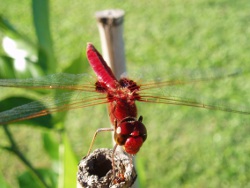|
|
InsectaArthropods have a body is divided into a head, thorax and abdomen[3].The Insecta are a class of Arthropoda that contains the greatest diversity of species than of any other group of animals. Insects body morphology includes, a three segmented body, an exoskeleton, compound eyes, antennae and three pairs of legs.
DescriptionHumans consider many insects as pests as they damage crops and food resources and spread diseases. However, many insects perform beneficial roles for humans such as pollination of plants (including food crops), breakdown carrion (detritivores) and produce or are food and resources themselves (e.g. bees produce honey, silkworms produce silk). Many insect families are recognised as having an aquatic life-stage. Some commonly-known insect orders containing aquatic families includes true water bugs (hemiptera), aquatic beetles (coleoptera), flies and true flies (diptera), caddisfly larvae (trichoptera), mayfly larvae (ephemeroptera), stonefly larvae (plecoptera) and dragonfly larvae (odonata). Aquatic insects are important components of wetland ecosystems. They are food for many other animals, including fish, platypus and birds. They are also important for their role in cycling nutrients and carbon through wetland systems. Aquatic insects and other invertebrates have different sensitivities to pollution and for that reason are indicators in wetland assessments. They respond to many kinds of changes in water quality or to physical disturbance to the wetland structure, hydrology or the landscape around the site[1]. To find out more about species in your area see WetlandSummary. For specific information on wetland species sightings please go to WetlandMaps or Wildlife Online. Additional information
References
Last updated: 13 April 2017 This page should be cited as: Department of Environment, Science and Innovation, Queensland (2017) Insecta, WetlandInfo website, accessed 18 March 2024. Available at: https://wetlandinfo.des.qld.gov.au/wetlands/ecology/components/biota/fauna/fauna-taxon/invertebrates/arthropoda/insecta.html |

 — Department of Environment, Science and Innovation
— Department of Environment, Science and Innovation


